- Home
- Encyclopedia
- Who First Climbed The Grand?
Who First Climbed the Grand?
Disputes over who first climbed certain Wyoming mountains date to the earliest times of Euro-Americans in the West. One of the first was about which peak of the Wind River Range fur trader Capt. Benjamin L.E. Bonneville climbed in 1832 while trying to find a shortcut from the Wind River Valley to the upper Green River. Another dispute concerns which major peak in the same range 2nd Lt. John C. Fremont climbed on his first expedition to the Rocky Mountains in 1842.[1]
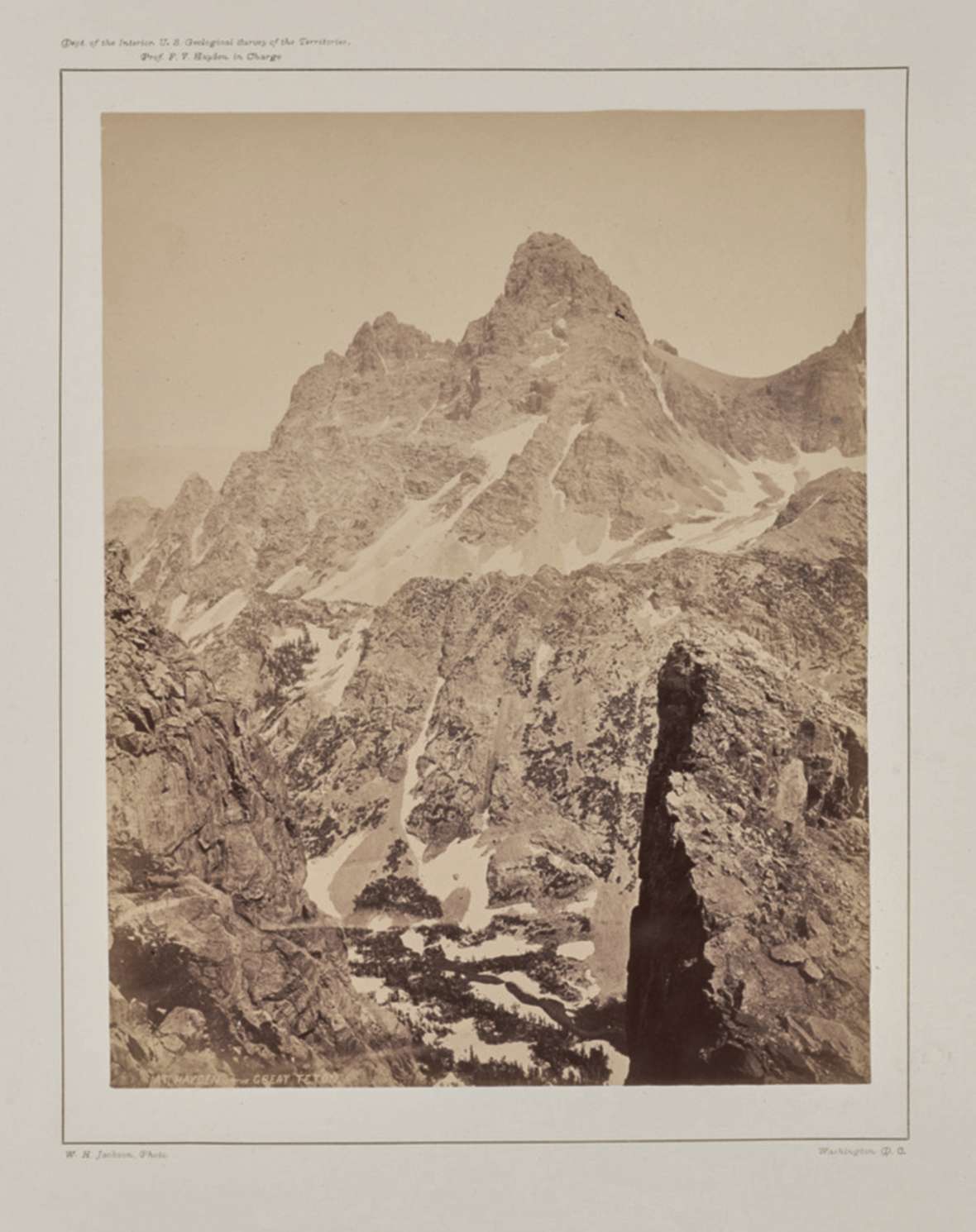
Yet another disagreement involves the question of which Euro Americans were first to climb the Grand Teton. At 13,776 feet, the Grand is the highest mountain of the dramatic Teton Range and dominates the skyline on the west side of Jackson Hole. On the western, subsidiary summit of the mountain is a rock structure of standing stones in a circle six feet in diameter, clearly showing that Native Americans, perhaps on a regular basis, spent time at or near the top.

The modern Grand Teton climbing controversy arose soon after publication of a notice by William O. (Billy) Owen in a September 1898 number of Forest and Stream magazine, about his ascent of the peak on Aug. 11 of that year. Owen, of Laramie, Wyo., was nearing the end of his first and only four-year term as Wyoming state auditor. He was about 40 years old, a longtime land surveyor, avid outdoorsman and occasional writer who from time to time published magazine pieces about his exploits: In 1883, for example, he and two friends had been the first people ever to bicycle across Yellowstone National Park. In the 1898 notice, he wrote that his party was the first to climb the mountain.
Soon after Owen’s notice, the magazine published a letter from Nathaniel P. Langford, which claimed he had climbed the mountain on July 29, 1872, as part of the activities of the southern branch of the 1872 Hayden Expedition to explore the Yellowstone area. Ferdinand V. Hayden’s expedition was one of four government surveys evaluating land, water, minerals and economic prospects around the Westin the 1870s. Langford had described his climb at greater length in a Scribner’s Monthly article in 1873.
A second objection to Owen’s claim to be first up the mountain came in a letter from U.S. Army Capt. William Kieffer who reported an ascent of the Grand Teton in September 1893. Owen never mentioned this letter, however. A researcher discovered it among Owen’s papers in what is now the University of Wyoming’s American Heritage Center in 1959.
Since that time, much has been written about these purported ascents.[2]Each bears further scrutiny and they will be discussed below in reverse chronological order.
The Owen ascent, 1898
On Aug. 11, 1898, Billy Owen, accompanied by the Rev. Franklin Spalding and ranch hands John Shive and Frank Peterson, made an ascent of the Grand Teton by way of the route which now bears Owen’s and Spalding’s names. Spalding, a veteran of many Colorado climbs, was the true leader on the more technical part of the climb at the top of the mountain. The four men returned two days later to make a second ascent. This time, they carried a camera to document their accomplishment.
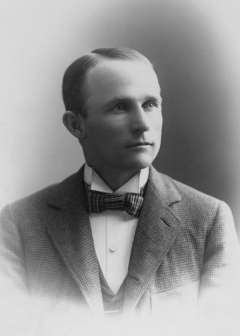
Owen published several articles about the climbs, igniting a firestorm of correspondence in the magazines between him and others associated with the purported 1872 ascent. Some letters claimed that Langford and Stevenson did not make it to the top; others supported their claim of the summit.
To assure his place in history, Owen embarked on a 30-year publicity campaign. Finally he persuaded the 1929 Wyoming Legislature to pass and Gov. Frank Emerson to sign legislation declaring his party first ascenders of the Grand. After the resolution passed, Owen and his wife Emma Matilda purchased a cast brass plaque memorializing the ascent. On July 30, 1929—the day after the dedication of Grand Teton National Park—two rangers and a third person installed the plaque on the Grand Teton summit. In an apparent protest of Owen’s claims, or perhaps in support of Langford’s, the plaque disappeared in 1977. Owen’s self-promotion appears to have created ill will among climbers and others of several generations.
The Kieffer ascent, 1893
Capt. William Kieffer, an Army surgeon stationed in 1893 at Fort Yellowstone near Mammoth Hot Springs in Yellowstone National Park, wrote to Owen in April 1899. In the letter Kieffer indicated that he and two enlisted men, while on a hunting trip to Jackson Hole in September 1893, made an ascent of the Grand Teton over a period of four days. Dr. Kieffer’s letter also contained a sketch of the route taken. Kieffer later attempted to contact the two men, but both had mustered out of the Army and dropped out of sight. Kieffer also indicated that he returned in the summer of 1894 to repeat the ascent and found a critical snowfield used in his 1893 ascent had melted. Because of that, he could not repeat his previous climb.
Many years later, an examination of Kieffer’s sketch by experts on the topography of the upper mountain showed that the route he took is in the area of the complete Exum Ridge, a route not known to have been climbed until 1940, using what was then state-of-the-art mountaineering techniques and equipment. Even today, that route is a popular technical climb in the Tetons. The Kieffer letter, discovered in 1959 and transcribed in its entirety in O.H. and L.G. Bonney’s 1970 Guide to the Wyoming Mountains and Wilderness Areas, was never disclosed by Owen to anyone.[3]
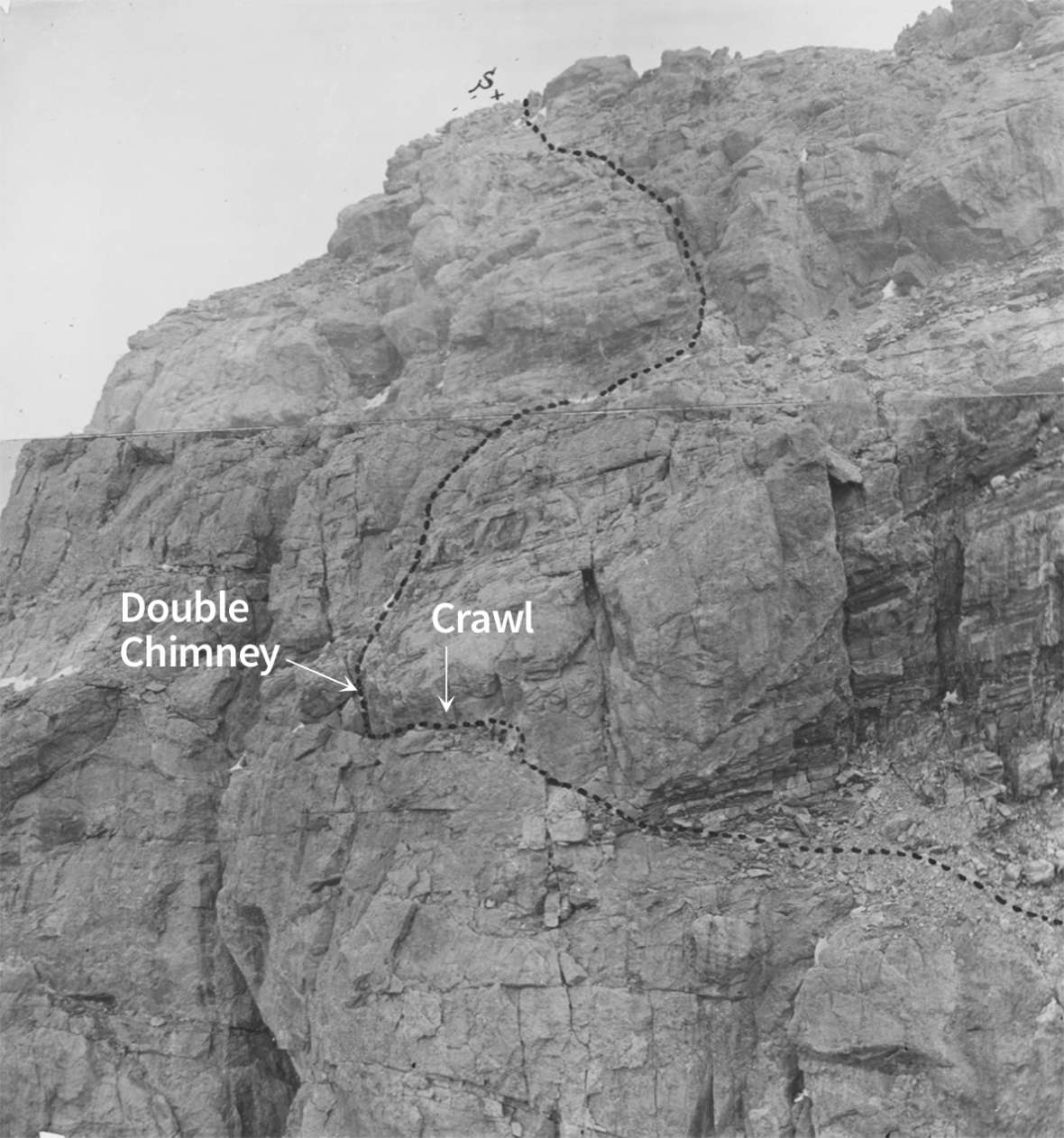
The Langford and Stevenson ascent, 1872
In the predawn hours of July 29, 1872, according to Nathaniel Langford’s 1873 article in Scribner’s Monthly, eleven brave souls from the southern division of the Hayden Expedition left their camp at the head of the south fork of Teton Creek, west of the Teton divide. Four soon turned back; two more would not reach the Lower Saddle between the Grand and Middle Tetons. This left Langford, James Stevenson, Frank Bradley and two teenagers—Sidford Hamp and Charles Spencer—to complete the ascent. Bradley stopped at the Saddle and would go no higher. The remaining four began the climb toward what is now called the Upper Saddle. After they had gone several hundred feet, the two teens chose to go no further, and waited instead for the return of Langford and Stevenson.
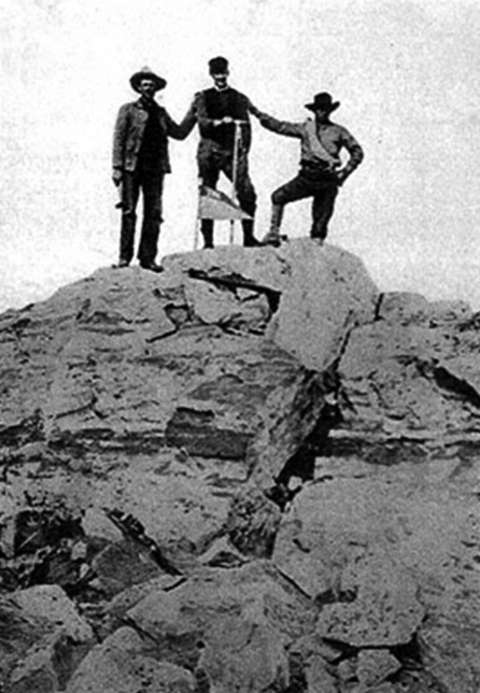
The Upper Saddle separates the Grand Teton from a lower, western subsidiary summit on which there exists a prehistoric structure called the Enclosure. Langford’s account notes “[W]e found a circular enclosure, six feet in diameter, composed of granite slabs, set up endwise about five feet in height…” making it clear they got at least this far.
From the Upper Saddle there is only one reasonable—but far from obvious—route up the 100-foot vertical cliff above the Upper Saddle. Any other route would require 20th century climbing gear and techniques. Beyond the Upper Saddle, all of Langford’s descriptions are incomplete and very general. Specific physical descriptions of the sections Owen called the “crawl” or “cooning place,” and beyond that the “double chimney,” are not included.
The controversy
In the battle of words that soon followed Owen’s 1898 publication, he found a number of faults in the Langford account. These errors included the description of the size of the summit, the lack of a cairn or any other evidence of a previous visit and Langford’s reference to the summit as “smooth and denuded.” Langford, however, stood by what he had written in 1873 and defended his honor. It now appears that both Langford and Owen were self-promoters with very large egos at stake.
Some supporters of the Langford -Stevenson ascent as the first believe that the 100-foot vertical cliff above the Upper Saddle was surmounted on a very large snow drift, using the assumption that 1872 was a “heavy snow” year. But an image made by Hayden expedition photographer William Henry Jackson within days of the 1872 ascent appears to refute that idea. The Jackson photograph, especially when compared with modern photographs of that same area, shows essentially no snow accumulated on the mountain above the Upper Saddle.
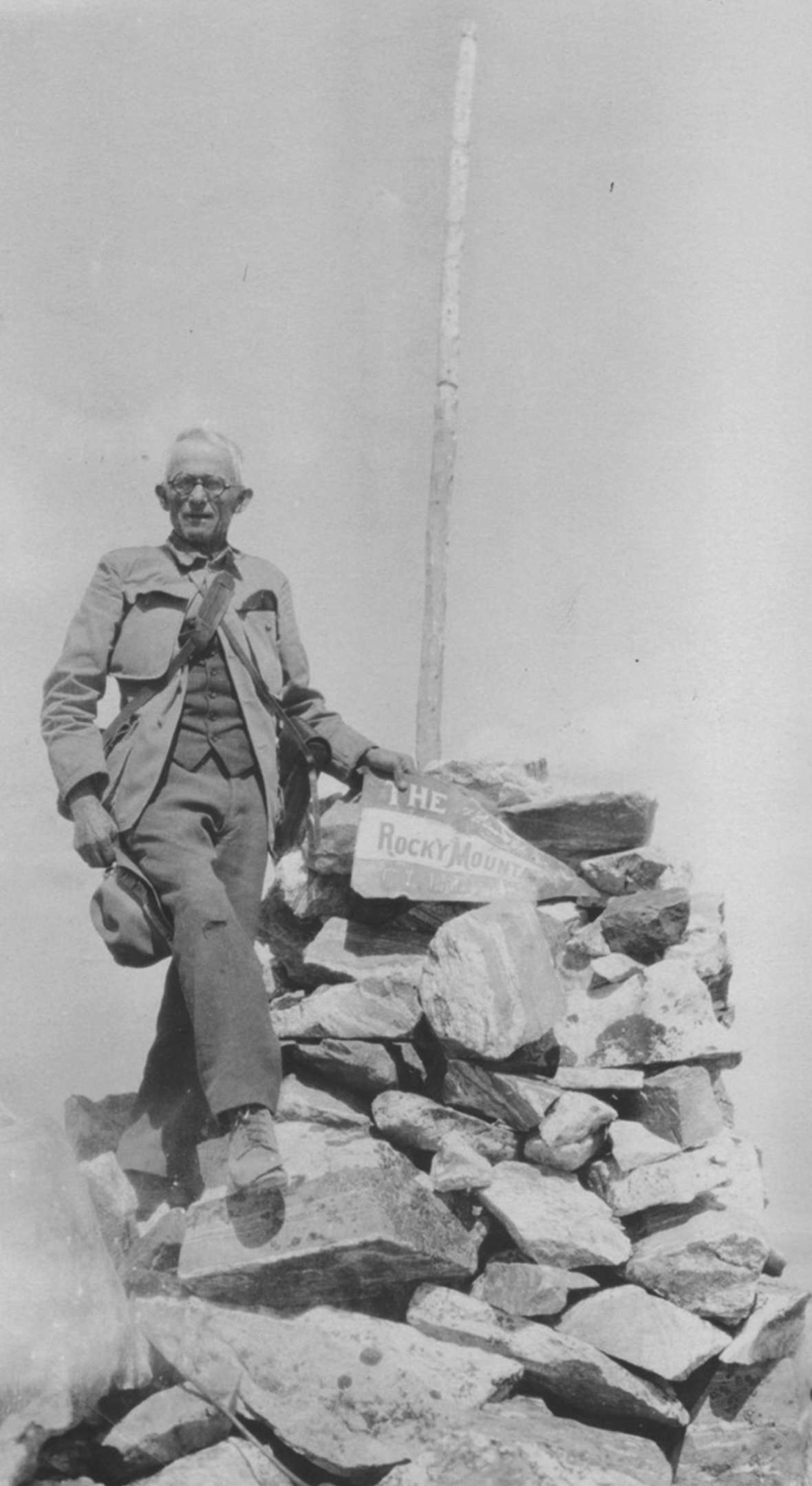
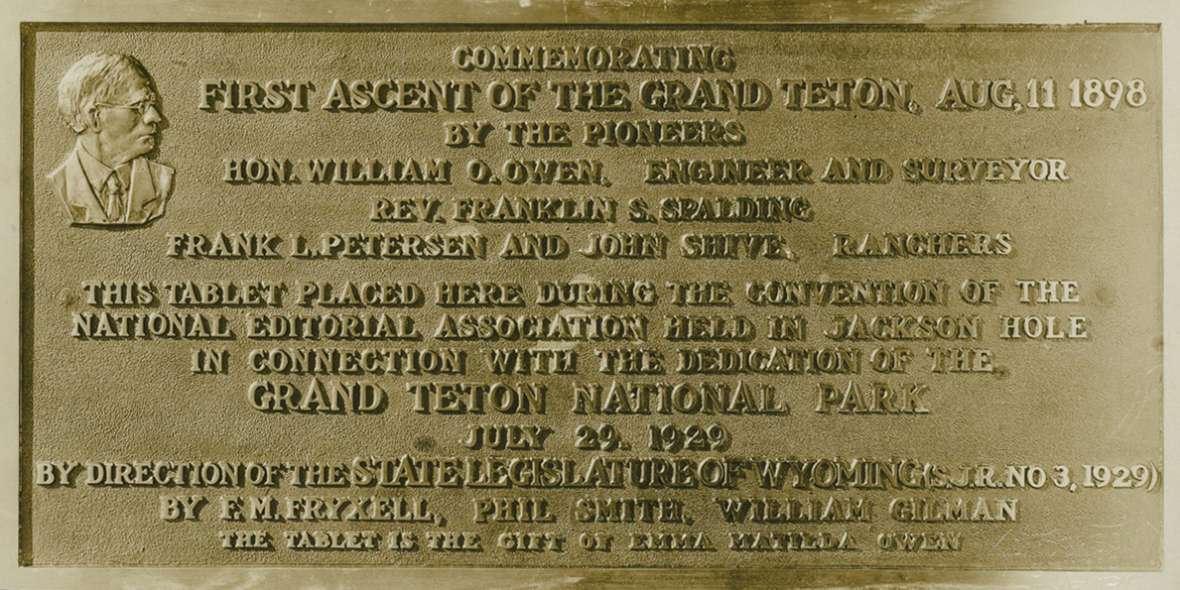
Humans did not attempt to summit the Grand Teton for the 25 years after Owen’s ascents. The third ascent was made in 1923 by Andy DePirro, David DeLap and Quin Blackburn, three students from the University of Montana with no experience in steep alpine climbing.[4]Two days after their ascent, Coloradans Albert Ellingwood and Eleanor Davis—the first woman to climb the Grand—reached the top. The following year, 1924, there were a number of ascents, including Paul Petzoldt’s first ascent with Ralph Herron. Petzoldt later went on to found the well-known National Outdoor Leadership School in Lander, Wyo. This was Petzoldt’s first ascent, but he made many more during the next 50 years.
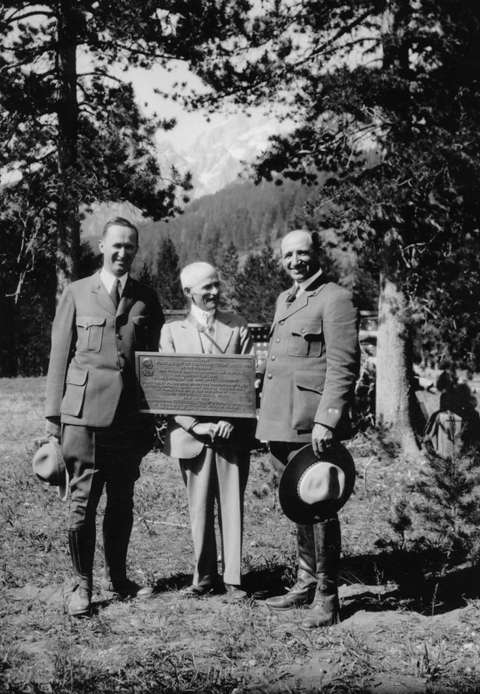
After the installation of the Owen plaque in 1929, the mountaineering community split into two camps on the question of who topped the mountain first. After the discovery of the Kieffer correspondence in 1959, some defected from the two camps to form a third, declaring Kieffer the victor.
In one 13-hour day in 1998 Rick Reese and Jim Fearick duplicated the Langford journey from Teton Creek to the top of the Enclosure and back, relying on extensive previous knowledge of the topography.[5]Reese has indicated that at least another two hours would have been required to go to the summit and return—and this was on a route they had previously climbed and descended many times.
Reese and Fearick’s climb did not resolve the historic dispute, however. Barring the discovery of new evidence, the controversy about who first summited the Grand continues.
Resources
Primary Sources
- Langford, N. P., “The Ascent of Mount Hayden,” Scribner’s Monthly, June, 1873, vol. 6, 123-157.
- Owen, W. O., “The Ascent of the Grand Teton,” Forest and Stream, Sept. 10, 1898, 202.
- William O. Owen Collection, American Heritage Center, University of Wyoming.
Secondary Sources
- Bonney, O. H. and L. G. The Grand Controversy.New York, The AAC Press, 1990, 1-124.
- ___________________. Guide to the Wyoming Mountains and Wilderness Areas: 3rd Ed. Chicago: Sage Books, Swallow Press, 1977, 64-65.
- Buhler, William. The Teton Controversy: Who First Climbed the Grand? Winona, Minn.: Saint Mary’s Press, 1980, 5-12.
- Fralick, Jack. “The Grand Controversy Revisited: Where was the Crux?” American Alpine News, vol.8 no. 223, Oct., 1998, 6-9.
- Irving, Washington. Adventures of Captain Bonneville U.S.A. New York: G.P. Putnam’s Sons,1837.
- Jackson, D. and Spence, M.L. The Expeditions of John Charles Fremont, Vol. I. Champaign-Urbana, Ill.: University of Illinois Press, 1970.
- Ortenburger, Leigh N. The Grand Teton, 1923: Beginnings of the Modern Era of Mountain Climbing in the Grand Teton National Park. San Jose, Calif.: Excel, 1968.
- Reese, Rick. “In the Footsteps of Nathaniel P. Langford and James Stevenson.” Unpublished manuscript in author’s collection detailing the 1998 re-creation of the one-day journey of the team led by Langford and Stevenson, in the author’s collection.
- Turiano, Thomas. Select Peaks of Greater Yellowstone.Jackson, Wyo., Indomitus Books, 2003, 32-34, 39-42.
Illustrations
- William Henry Jackson’s 1872 photo of the west side of the Grand Teton is from the collections at the J. Paul Getty Museum. Used with permission and thanks.
- The photo of Nathaniel P. Langford is from Wikipedia. Used with thanks.
- The photo of Owen’s three companions on the summit of the Grand Teton in 1898 is from Wyoming Tales and Trails. Used with thanks.
- The composite photo showing William Owen’s 1898 climbing routes and the 1924 photo of Owen alone on top of the Grand Teton are from the American Heritage Centerat the University of Wyoming. Used with permission and thanks.
- Author Jacquot notes that the painted steel sign is from the Rocky Mountain Club, a climbing club in Colorado around the turn of the century, of which the Rev. Frank Spalding was a member. It was placed on the summit either on the first or second ascent in 1898. Billy Owen was eager for the sponsorship of the club and that is one reason he recruited Spalding. The sponsorship meant that Billy got the club to pay for at least part of the bill for the horse packers to establish the high camp in the Shadow Peak Cirque near the start of the E. Ridge of Nez Perce Mountain.
- The portrait of Billy Owen, the photo of his plaque and the 1929 photo of him with Horace Albright at Grand Teton National Park in 1929 are from the Wyoming State Archives. Used with permission and thanks.
[1] Thomas Turiano, Select Peaks of Greater Yellowstone,(Jackson, Wyo.: Indomitus Books, 2003), 32-34, 39-42.
[2] W.O. Owen, “The Ascent of the Grand Teton,” Forest and Stream, Sept. 10, 1898, 202;
N.P. Langford, “The Ascent of Mount Hayden,” Scribner’s Monthly, June 1873, vol. 6, 123-157; William O. Owen Collection, American Heritage Center, University of Wyoming; William Buhler, The Teton Controversy: Who First Climbed the Grand? (Winona, Minn.: Saint Mary’s Press, 1980), 5-12; O.H. and L.G. Bonney, The Grand Controversy,(New York: The AAC Press, 1990), 1-124; Jack Fralick, “The Grand Controversy Revisited: Where was the Crux?” American Alpine News, vol. 8, no. 223, October 1998, 6-9.
[3] O.H. and L.G. Bonney, Guide to the Wyoming Mountains and Wilderness Areas, 3rd ed., (Chicago: Sage Books Swallow Press, 1977), 64-65.
[4] Leight N. Ortenburger, The Grand Teton 1923,(San Jose: Excel, 1968).
[5] Rick Reese, “In the Footsteps of Nathaniel P. Langford and James Stevenson,” unpublished manuscript detailing the 1998 re-creation of the one-day journey of the team led by Langford and Stevenson, in the author’s collection.
